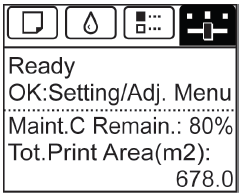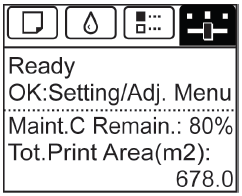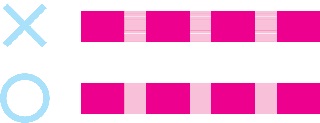|
If printed images are affected by banding in different colors across the sheet, execute [Adj. Quality] for automatic adjustment of the paper feed amount. There are two modes for [Adj. Quality]: [Auto] and [Manual] but normally execute [Auto]. Use [Manual] adjustment with highly transparent media or other paper for which [Auto(GenuinePpr)] or [Auto(Other-Paper)] cannot be used.
Automatic Banding Adjustment There are two modes of automatic adjustment to correct banding: [Auto(GenuinePpr)] and [Auto(OtherPaper)]. In either mode, the printer prints and reads a test pattern for automatic adjustment of the feed amount.
Use this mode with paper identified in the [Paper Reference Guide].
Use this mode with paper not in the [Paper Reference Guide], or if [Auto(GenuinePpr)] does not eliminate banding.
IMPORTANT
- Adjustment is not possible with Auto(GenuinePpr) and Auto(OtherPaper) when using highly transparent media.
In this case, use Manual adjustment.
- If you are using cut sheets, remove the Stacker from the printer.
NOTE
- We recommend executing the adjustment if you have changed the paper type or paper size.
- Always check the Adj. Priority values before using Auto(GenuinePpr) or Auto(OtherPaper).
- If additional fine-tuning is necessary after Auto(GenuinePpr) and Auto(OtherPaper), execute Adj. Fine Feed.
- Use Adjust Length to ensure that lines in CAD drawings are printed at exactly the right length.
- This may take some time, depending on the type of paper.
<Paper to Prepare>
When Using Rolls:
An unused roll at least 254.0 mm (10.00 in) wide
When Using Sheets:
Auto(GenuinePpr) : One sheet of unused paper, A4/Letter size
Auto(OtherPaper) : Two sheets of unused paper of at least A4/Letter size (or one sheet when using A2 or larger)
Perform adjustment as follows.
1. Load the paper.
IMPORTANT
- Always make sure the loaded paper matches the type of paper specified. Adjustment cannot be completed correctly unless the loaded paper matches the settings.
2. On the Tab Selection screen of the Control Panel, press  or  to select the Settings/Adj. tab (  ).

NOTE
- If the [Tab Selection screen] is not displayed, press the [Menu] button.
3. Press the [OK] button. The [Set./Adj. Menu] is displayed.
4. Press  or  to select [Adjust Printer], and then press the [OK] button.
5. Press  or  to select [Feed Priority], and then press the [OK] button.
6. Press  or  to select [Adj. Quality], and then press the [OK] button.
7. Press  or  to select [Auto(GenuinePpr)] or [Auto(OtherPaper)], and then press the [OK] button. A test pattern is printed for adjustment. Adjustment is now finished if you have printed on a roll or a sheet of A2 size or larger.
8. If you are printing on sheets smaller than A2 size for [Auto(OtherPaper)], a confirmation message is shown on the Display Screen requesting you to continue printing. Press the [OK] button and follow the instructions on the Display Screen.
Manual Banding Adjustment [Manual] adjustment requires you to enter an adjustment value after a test pattern is printed.
IMPORTANT
- If you are using cut sheets, remove the Stacker from the printer.
NOTE
- We recommend executing the adjustment if you have changed the paper type or paper size.
- Always check the Adj. Priority values before using Manual adjustment.
- If additional fine-tuning is necessary after Manual adjustment, use Adj. Fine Feed
- Use Adjust Length to ensure that lines in CAD drawings are printed at exactly the right length.
<Paper to Prepare>
When Using Rolls:
An unused roll at least 254.0 mm (10.00 in) wide
When Using Sheets:
Two sheets of unused paper of at least A4/Letter size
Perform adjustment as follows.
1. Load the paper.
IMPORTANT
- Always make sure the loaded paper matches the type of paper specified. Adjustment cannot be completed correctly unless the loaded paper matches the settings.
2. On the Tab Selection screen of the Control Panel, press  or  to select the Settings/Adj. tab (  ).

NOTE
- If the [Tab Selection screen] is not displayed, press the [Menu] button.
3. Press the [OK] button. The [Set./Adj. Menu] is displayed.
4. Press  or  to select [Adjust Printer], and then press the [OK] button.
5. Press  or  to select [Feed Priority], and then press the [OK] button.
6. Press  or  to select [Adj. Quality], and then press the [OK] button.
7. Press  or  to select [Manual], and then press the [OK] button. Test pattern A is printed for manual adjustment.
NOTE
- When printing on sheets, follow the instructions on the Display Screen and remove the sheet.
8. Examine test pattern A for adjustment. Determine the pattern in which banding is least noticeable.

NOTE
- If banding seems least noticeable in two patterns but you cannot decide which one is better, choose an intermediate value. For example, choose 11 if you cannot decide whether pattern 10 or 12 is better.
9. Press  or  to select the pattern number you have decided, and then press the [OK] button. Test pattern B is printed for adjustment.
NOTE
- If you printed test pattern A on a sheet, follow the instructions on the Display Screen and use another sheet of the same type of paper. Additionally, after test pattern B is printed, follow the instructions on the Display Screen and remove the sheet.
10. Examine test pattern B for adjustment. Determine the pattern in which banding is least noticeable.
11. Press  or  to select the pattern number you have decided, and then press the [OK] button. The adjustment value is now registered, and adjustment is complete.
|